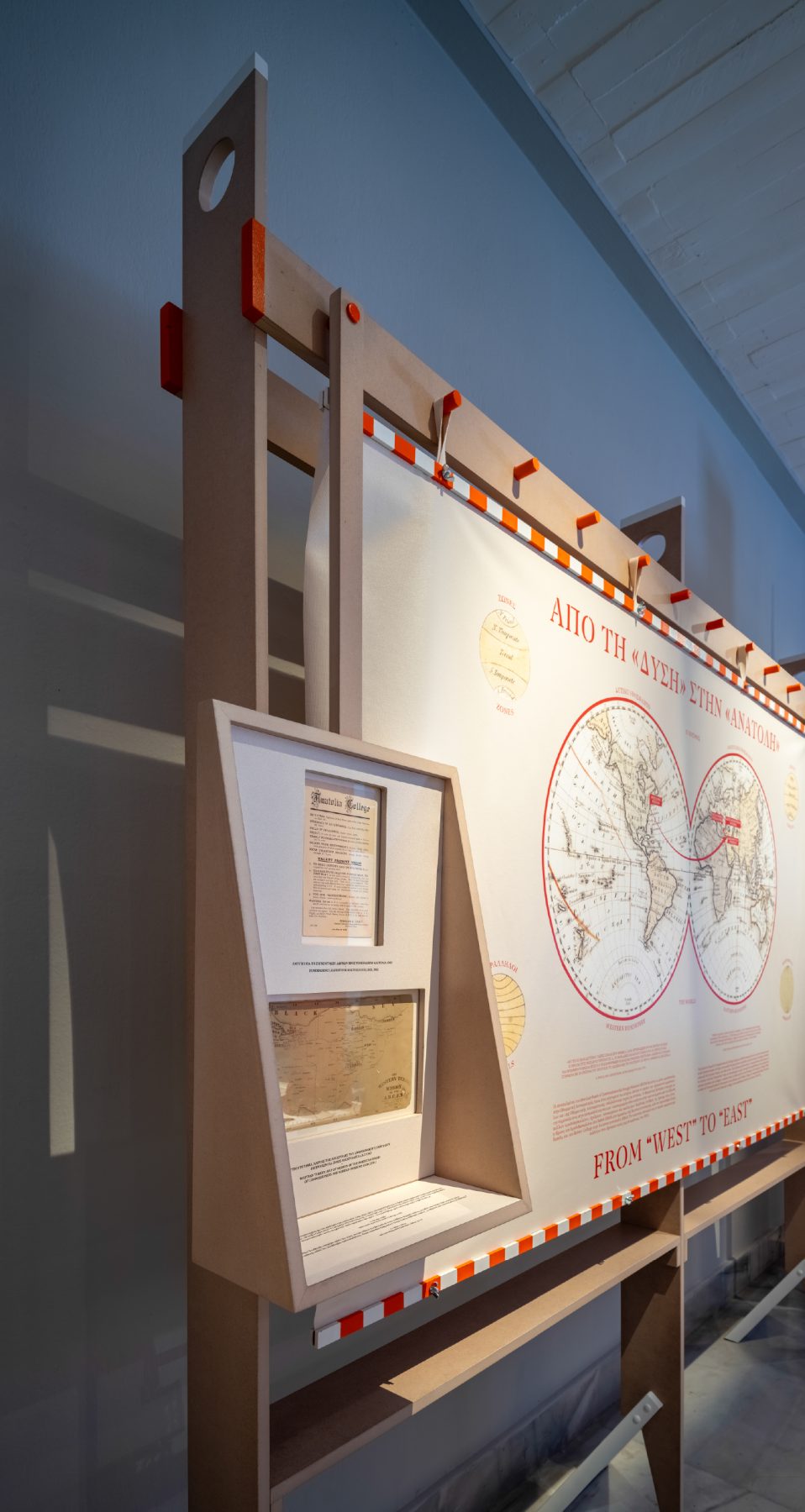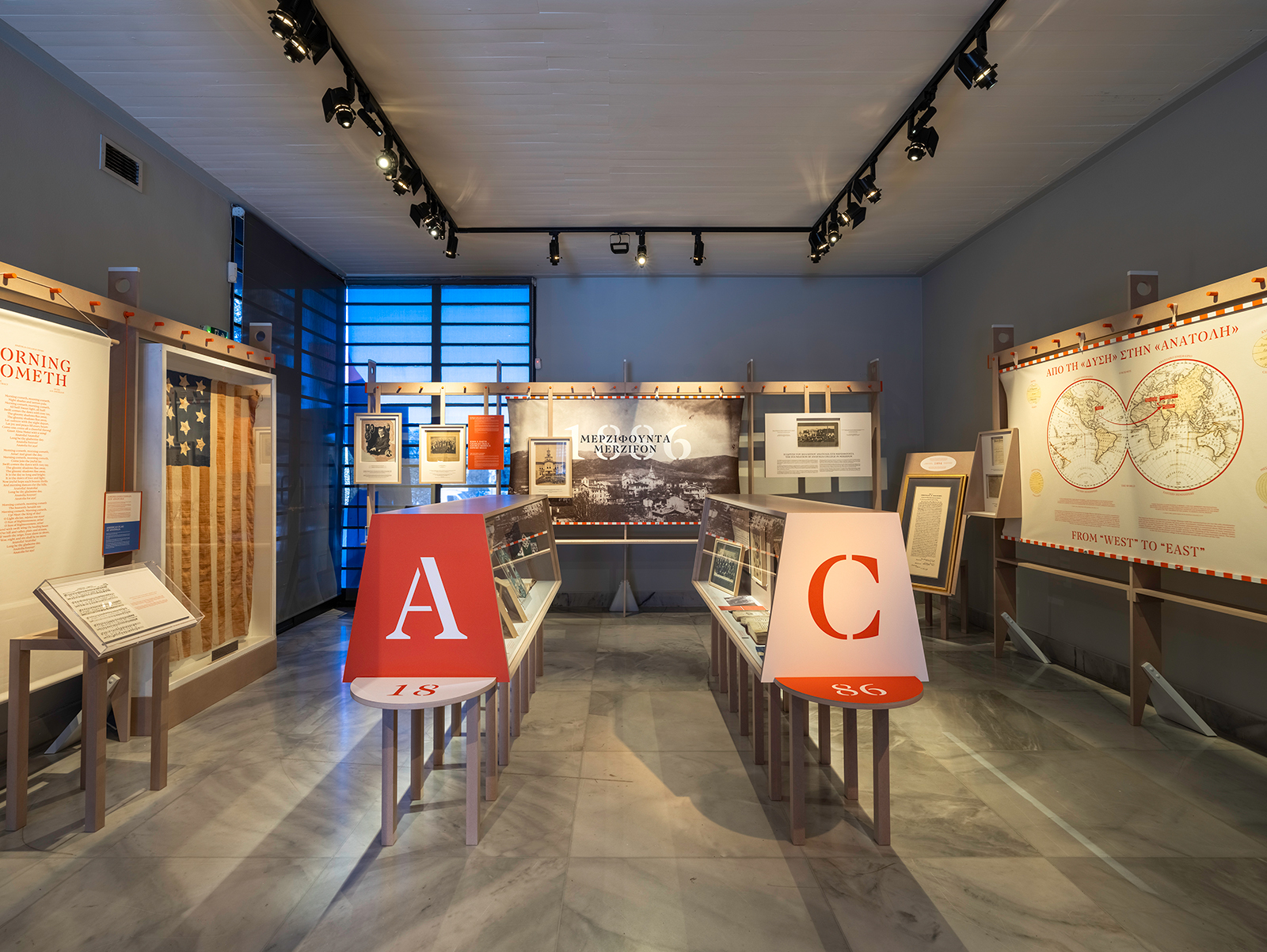Τwo exhibition spaces designed by Post-Spectacular Office awarded at GRAIL Awards 2025: Future Cometh, a space for the celebration of 100 Years of the Anatolia College in Thessaloniki, as an opportunity for celebration, reflection, contemplation, self-knowledge and plans for the future. Perrakis Papers, as a pavilion that conveys a sense of technical sophistication, reflecting both the aesthetic values of Perrakis Papers and the expertise behind its products.
Future Cometh
Anatolia College. 100 years in Thessaloniki – Exhibiting an American educational institution in Thessaloniki, Greece -Museum of Byzantine Culture
A centennial anniversary offers an opportunity for celebration, reflection, contemplation, self-knowledge and plans for the future. Marking 100 years since its beginnings in Thessaloniki, Anatolia College is addressing the city’s public to tell its story through an exhibition being held in the heart of the city.
In designing the narrative of the exhibition, the members of the curatorial team rhetorically asked in which manner can one “present” a school, the history of which is intertwined with the hi story of three places—America, the Pontus, Greece—and which evolves over three centuries, from the 19th to the 21st century. During our research, we ascertained that the long and turbulent history of the College sheds light on moments from the modern history of the Ottoman Empire and of Greece, revealing aspects of the international relations between America and Greece, “East” (Anatoli) and “West”, as well as more specific issues such as the rise and acme of the American missionary movement, its transformation, and its role in the so-called “Westernization” of the “East”.
With these initial thoughts, we proceeded to interpreting the story of Anatolia College through the two overlapping levels of history: macrohistory and microhistory.
Anatolia’s Centennial exhibition is arranged in three units. It showcases the rich archival material of Anatolia College, such as historical objects, photographs, videos, public documents, personal notes and student publications, the largest part of which is housed in the Bissell Library. In addition, a great amount of primary and secondary sources were also studied to document the historical, socio-political and cultural context of Anatolia’s course over the 100 years of its history.
The first unit of the exhibition covers the “early” history of Anatolia College in Asia Minor, during which time the foundations for its subsequent path are laid. The beginnings of the American Board of Commissioners for Foreign Missions (ABCFM), based in Boston, are presented, which are linked to the establishment of schools and hospitals in the Ottoman Empire. Bebek Seminary (1840) and Robert College in Constantinople (1863) formed the original core from which, after the split and relocation of the Seminary to Merzifon, the history of Anatolia College begins, which was founded in 1886 as a College of Liberal Arts. Through a presentation of the work of the College and the four-year secular education it offered, reference is made to the Armenian and Greek Orthodox community of Merzifon and their relationship to the school, and to the conflicts with the Ottoman administration and later with the Young Turk regime, which eventually led to Anatolia leaving the region.
The second unit follows the school’s relocation from Merzifon to Thessaloniki, initially to the district of Charilaou and then, to the College’s current location in Pylea. Anatolia takes root in its new home, although the school’s relationship as an American college with the state policy in Greece has its ups and downs.
At the same time, the central theme of the second unit is a presentation of the facilities of Anatolia College in Pylea, which constitute the spatial expression of the school’s educational vision and identity.
The principles of inclusion, educational innovation, social responsibility, and excellence are expressed in the outdoor spaces and the premises of the College.
At the same time, they form the basis and framework for the development of its curriculum. The latter is designed as a hybrid curriculum that draws significantly from the American education system for the humanities while it has simultaneously been adapted to the Greek conditions for secondary education.
In this context, individual topics are presented that relate to the educational principles governing the operation of Anatolia, such as experiential learning, sports, innovation, inclusion and an international orientation.
These principles are incorporated into all the education levels that are later to be created, and which include primary education, higher education and the international Pinewood School. These comprise the structure of Anatolia College today.
The third and final unit of the exhibition focuses on the microhistories of the school from within. The space on the second floor is a space that is experiential and interactive, aspiring to evoke feelings of joy, discovery, and emotion. Visitors are invited to leaf through the school yearbooks, read student publications, listen to audio excerpts from recordings of students in rhetoric competitions, and watch video clips of the productions of the student theater clubs. In this unit, the school’s extracurricular clubs—another school within the regular school—are presented. In creative ways, they give each student the opportunity to discover his or her special talents and skills, beyond the regular school program.
Each unit of the exhibition is designed differently, so as to impart the content of the museological narrative while maintaining a unified style of the graphic design and construction materials. In the introductory unit, which recounts Anatolia’s early years in Merzifon, the design of the constructions is influenced by the distinctive style of the simple furniture of the Protestant Shaker communities. In the main room of the exhibition, where the second unit is displayed, the narrative of 100 years in Thessaloniki employs small desks to mimic the feeling of being inside a classroom. On the first floor of the exhibition space, where the third and final unit of the exhibition is displayed, small scale structures host objects that reflect how students spend their free time, outside the strict school schedule and impart to visitors the creativity, camaraderie and joy that characterize participation in the school’s extracurricular activities.
Facts & Credits
Project title Future Cometh
Typology Exhibition space design
Location Anatolia College, Thessaloniki
Artistic Direction and Curation Post-Spectacular Office ⁄ Stergios Galikas
Museological Study Post-Spectacular Office ⁄ Stergios Galikas, Alkmini Paka, Dr. Angeliki Tsiotinou (Partner)
Museographical Design Post-Spectacular Office / Stergios Galikas, Alkmini Paka
Architectural Design Post-Spectacular Office ⁄ Stergios Galikas, Evelina Garantzioti, Elli Christaki
Visual Identity and Environmental Graphics Post-Spectacular Office ⁄ Stergios Galikas, Nikos Antonopoulos, Takis Dimitriadis
Production Management Jenny Delichristou ⁄ Jade Communications Angeliki Sapika
Scientific Research-Documentation Alkmini Paka Dr. Angeliki Tsiotinou
Research of Sources and Compilation of Primary Sources Christos Plousios Dr. Evi Tramantza
Archival Research, Research of Sources and Compilation of Exhibition Material Post-Spectacular Office ⁄ Stergios Galikas, Alkmini Paka, Dr. Angeliki Tsiotino
Research of Sources and Compilation \ of Exhibition Material Jenny Delichristou, Suzana Giouvanoudi, Efthymia Kompouri, Angeliki Sapika, Anna Maria Xygalidou
Research, Editing and Archival Material Management Stella Asderi, Jenny Delichristou, Suzana Giouvanoudi, Efthymia Kompouri, Lena Markoudi, Alkmini Paka, Maria Rampota, Angeliki Sapika, Dr. Evi Tramantza, Dr. Angeliki Tsiotinou, Liza Vachtsevanou, Anna Maria Xygalidou
Scientific and Museological Editing of Exhibition Texts Alkmini Paka, Dr. Angeliki Tsiotinou
Video Alexandra Niaka
Text provided by the architects
Perrakis Papers, Thessaloniki Book Fair 2024
The Perrakis Papers pavilion at the 2024 Thessaloniki Book Fair is a refined, precisely crafted space that embodies the premium quality and precision of the brand.
Designed with slim inox surfaces and deep blue coloured MDF panels, the pavilion conveys a sense of technical sophistication, reflecting both the aesthetic values of Perrakis Papers and the expertise behind its products.
The choice of inox, with its sleek and blade-like edges, adds a sense of rigor and precision, subtly referencing the technical processes that underpin high-performance paper production—the very essence of the Perrakis Papers brand.
The blue MDF panels, uniform in hue, evoke the immersive quality of ink on paper, adding a nod to the foundational materials in 2D representation and paper materiality.
This controlled color palette and material contrast allow the pavilion to highlight the technical and intellectual drive of the brand while maintaining a clean, focused aesthetic. Each element is selected to signify stages in the paper-making process, making the structure not just a display but a narrative of craftsmanship and quality.
In its minimalist layout and exacting material choices, the pavilion transforms the act of viewing paper into a ritual of appreciation, inviting visitors to engage with the product as a refined, high-performance result of intricate processes and exacting standards. The projection mapping that occurs on the blank surfaces of the multicoloured papers underlines the limitless possibilities of the material when used by creatives.
Facts & Credits
Project title Perrakis Papers
Typology Exhibition space design
Architectural Design Post-Spectacular Office
Photography Stefanos Tsakiris
Text provided by the architects
READ ALSO: apt. ERMOU 18, Reflections of Athens by Emi Georgosopoulou & Alexandra Zarani

























